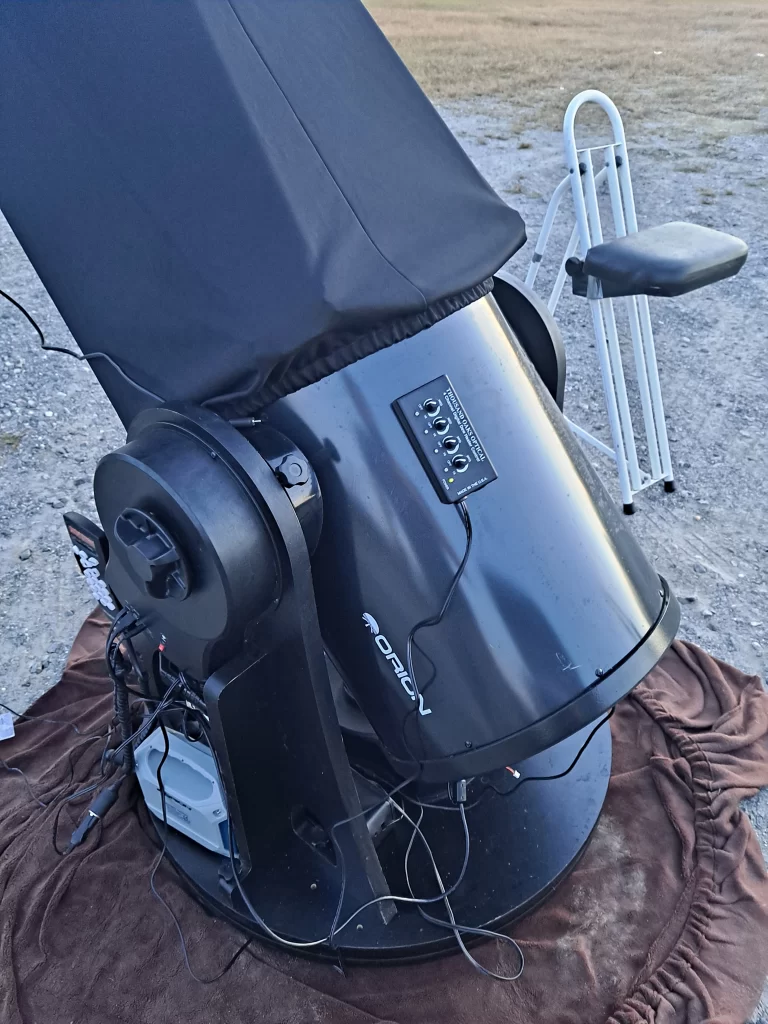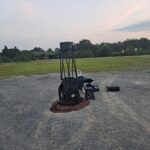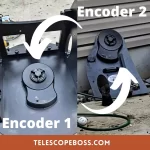The first thing you should do when setting up your telescope is to turn on the cooling fans.
A cooling fan helps your telescope acclimate, or come to the same temperature as the air. They move the air around the mirror to help it cool quickly. These fans should be mounted behind your mirrors, directing air to your mirror. They keep your mirrors from accumulating dew.
Keeping your telescope temperature controlled is important for observing. If the temperature of your telescope is very different from the surrounding air then you will have dew or condensation. This makes observing difficult or impossible.
Because the fans get air from the ground and direct it to the mirrors, you want to be careful about dirt and dust.
I observe in a gravel lot and I put a sheet down before I set up the scope. It is a small amount of protection but it makes me feel a lot better.
Some friends of mine also use box fans and hair dryers for a similar purpose. They direct a box fan at the scope to keep air circulating around the scope.
Hair dryers are often used to quickly dry an optical surface as well.
This is not an issue in every climate, but if you are observing in an area with high humidity or extreme temperature fluxuations you will notice fog on your mirrors and eyepieces. If this is an issue for you, where you are observing, then you will need to use cooling fans and warmers to keep your views clear.
More information about acclimation can be found in this post.
Why do telescopes have cooling fans?
When you are using a telescope it needs to be the same temperature as the air around it, or very close.
A cooling fan helps speed up the process of acclimation. It moves air over the mirror to cool it down to the same temperature as the air, or the ambient temperature.
If it is warmer outside than in your home, you still need a cooling fan to circulate the air around the mirror.
The term “cooling fan” is a bit misleading, because it is not just used to cool the mirror, it is used to try to keep the temperature more stable around the mirror.
It is important to leave it on if the temperature is changing quickly. Because we are observing at night, there can be some dramatic temperature shifts.
I usually only run my fans for an hour or so, but I think next time I am going to try to run them the whole time. I think this might be a better solution for me. I am constantly battling dew in high humidity conditions.
A few months ago, I brought my 10 inch dobsonian out when my fans were broken and it took well over 2 hours to acclimate.
How do I power my telescope’s cooling fans?
Cooling fans require electricity. They are normally powered with a battery pack. A plastic shell that holds traditional AA or 12v batteries.
Be sure to check your fan before leaving home to be sure the batteries are still good. You could also just choose to carry extra batteries.
When to use your fan for a Dobsonian telescope?

Your Dobsonian likely came with installed fans. They may be powered by a battery pack or they may need to be plugged in.
If you have the Orion cooling fans the manual gives the recommendation to only run the fans for 20-30 minutes. Longer if you have a large scope.
Using your cooling fans at the right times can make your views much crisper.
When you set up
The first thing I do when I set up my dobsonian telescope is to turn on the cooling fans.
While some people say that you can run your fans the whole time you are observing, I only use mine for the first hour or so.
Seeing Distortion
If you start seeing distortion, and your scope has had plenty of time to acclimate, you should turn your fans off.
The moving air can create currents of air that degrade the seeing. Seeing is a term used by astronomers to describe the clarity of the atmosphere. If you have ever seen heat rising off a car engine or sidewalk you have an idea of how the temperatures of air can distort an image.
The different temperatures of air inside your optical tube can create the same conditions.
This distortion can happen high in the atmosphere as well, when hot and cold air make seeing difficult.
This happened to me last night when I was observing Venus, it was a bit low on the horizon and it was shaking, and the edges looked blurry. That was one of the first things I observed last night. I have a huge scope with a very thick mirror, so I wonder if the scope was still not acclimated properly. I was seeing distortions, and those could have been a result of the air in my optical tube or air in the atmosphere.
If you leave your fan on the entire time you are observing you may experience better seeing. It keeps the air moving, so you are less likely to experience great differences in temperature between the air in front of the mirror and the air behind the mirror.
When the temperature changes quickly
If the temperature changes quickly you should turn your fans back on for another 20 to 30 minutes to help the scope more quickly come to ambient temperature.
While the manufacturer of these telescope cooling fans only recommend that you run them intermittently, if you have the power you can run them continuously.
There are opinions on both sides, just see what works for you and your telescope in your climate.
Just be sure that you know how to easily turn them off. For many fans the only way to do that is to disconnect them from the battery pack.
How do you cool down a telescope?
The best way to cool down a telescope is to let it sit outside where you will be observing for at least an hour. If you want to speed up the process you can use a cooling fan to help circulate the air over the mirror. You may also choose to store your telescope in an unheated shed or backyard observatory to eliminate the need for acclimation.
Be sure to consider your eyepieces as well. I am very happy with my eyepiece storage, you can see my recommendations here.
No matter the outside temperature your telescope needs to be the same temperature of the air.
If you are bringing a warm telescope out into a cold night, expect to let it acclimate for a hour or more. The larger the scope, and the thicker the mirror, the longer the acclimation will take. Read our handy guide to acclimation here.
You can speed up telescope cool down, by bringing your scope out into your car early in the day.
I mostly observe in a gravel lot that is about a half mile from my house. I tend to load up my gear in the afternoon, so everything can start to cool down for the night.
Your telescope will work best when it is at the same temperature as the air around it. If the temperate of your scope is different from the surrounding air any water that is in the air will accumulate on your glass and metal surfaces.
This makes your views blurry at best, impossible at worst.
I use lots and lots of gear to keep my scope free of dew.
Here is my most current set up:
Can I stop a cooling fan from vibrating?
Cooling fans are advertised as running with zero vibrations. This has been my experience, but some people report that the fans do create slight vibrations that annoy them.
If your cooling fans are creating vibrations that are making your views blurry you can add neoprene or rubber grommets in between the fan and the scope.
It is not all or nothing, if you are doing visual observing and you notice vibrations from the fan when using high magnification, just turn off the fans for a little bit. If the scope has had time to acclimate, you won’t immediately get dew in most conditions.
This would be more important the greater your magnification. Any slight disruptions to your equipment will be more noticeable at higher magnifications.
So, I am not yet into astrophotography, but I usually hear the complaints about vibration from the photographers.
This makes sense because even slight bumps to the image will make it blurry. If you are doing long exposure astrophotography, consider installing the rubber grommets or turning off the fans even if you do not notice any vibrations with the eye. The camera will pick up on smaller movements.
Can I install my own cooling fans on my telescope?
When the factory ones fail, you can buy replacements.
Muffin fans are a cheap, reliable choice for replacing your factory cooling fans. They can be installed using parts that are available at the hardware store or technology store. These fans are often installed on computers to keep the parts from overheating.
I am going to film a video of installing these fans myself, then I will update this article.
Do you use a cooling fan in the winter?
Cooling fans are about acclimation. They are not just for cooling
Cold air does not hold moisture as well as warm air. This means that the air more easily leaves that water on the glass of your optical surfaces. Keeping a fan moving the air will make it harder for dew to accumulate on your mirrors.
As in any conditions, be sure to use your fans any time the temperature changes drastically.
You can run them for 15 to 20 minutes and see if you notice an improvement.
It can be so confusing. I am not sure that I understand it all very well. I have a complex set up with dew heaters, cooling fans and a truss tube that are all suppose to make the acclimation easier, but there are nights I still get frustrated and discouraged.
In the end, you have to learn all you can and try lots of things to find out what works for your set up in your conditions.





